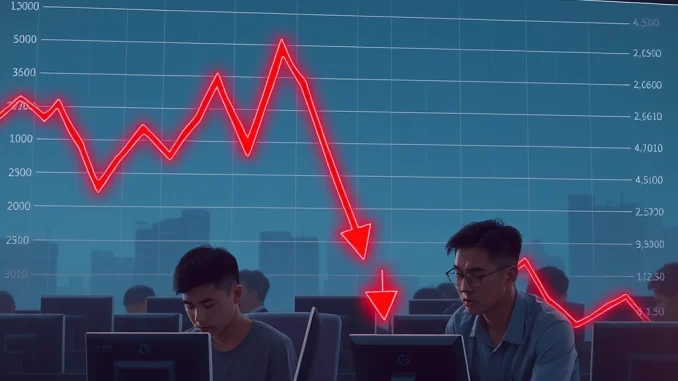
Is XRP bracing for a significant shift? Recent market activity on South Korean exchange Upbit suggests a surge in sell pressure, primarily driven by Korean traders. This development has ignited discussions about a potential consolidation phase for XRP. Let’s dive into the details and understand what this could mean for investors.
Why is XRP Sell Pressure Surging on Upbit?
Market analyst Dom’s recent analysis, highlighted by Cointelegraph, sheds light on this intriguing trend. Between April 6th and 7th, a staggering 1.4 million XRP/KRW trades were executed on Upbit. Here’s the crucial detail: 62% of these trades were sell orders. This imbalance points towards a growing bearish sentiment among Korean traders.
To put this into perspective:
- Massive Trading Volume: 1.4 million XRP/KRW trades in just two days.
- Dominant Sell Orders: 62% of trades were sell orders, indicating strong selling interest.
- Significant Net Outflow: This translates to a net sale of approximately $120 million worth of XRP within this short period.
- Declining Confidence: The data suggests a decrease in investor confidence in XRP, at least among Korean traders on Upbit.
This substantial sell pressure can be visualized as a wave of investors choosing to reduce their XRP holdings, potentially fearing further price declines or seeking to capitalize on profits before a potential downturn.
What Does This Sell Pressure Imply for XRP Consolidation?
Cointelegraph’s report further elaborates on the technical implications of this sell pressure. A critical level to watch is the 200-day moving average (DMA). Currently hovering around $1.82, this DMA acts as a crucial support level.
The Danger Zone: Below the 200-day Moving Average
If XRP’s daily candle closes below this 200-day moving average, it could signal the beginning of a prolonged consolidation phase. Think of it as a price range where XRP might trade sideways for an extended period, lacking a clear upward or downward trend. This consolidation can be frustrating for traders looking for quick gains, but it can also be a period of accumulation before the next major move.
Key Demand Zone: A Potential Silver Lining?
However, it’s not all doom and gloom. Analysts point to a key demand zone between $1.63 and $1.27. This zone represents a price range where buyers might step in and start accumulating XRP. Demand zones are areas where historically, buying interest has been strong enough to halt price declines and potentially trigger rallies.
Let’s break down the potential scenarios:
| Scenario | Trigger | Potential Outcome |
|---|---|---|
| Prolonged Consolidation | XRP daily candle closes below 200-day DMA ($1.82) | Sideways trading between $1.82 and demand zone ($1.63 – $1.27). Potential accumulation phase. |
| Further Downward Pressure | Demand zone ($1.63 – $1.27) fails to hold | Potential test of lower support levels. Increased bearish sentiment. |
| Bounce Back | Demand zone ($1.63 – $1.27) holds strong | Potential price rebound. Bullish momentum could return if 200-day DMA is reclaimed. |
What Should XRP Investors Watch For?
For those holding XRP or considering investing, here are some actionable insights:
- Monitor the 200-day DMA: Closely observe if XRP closes below $1.82 on the daily chart. This is a critical level to watch for potential consolidation.
- Track Upbit Trading Volume: Keep an eye on trading activity on Upbit, especially the buy/sell ratio. Continued high sell pressure could reinforce the bearish trend.
- Observe the Demand Zone: Pay attention to how XRP behaves within the $1.63 – $1.27 demand zone. Strong buying activity in this zone could signal a potential reversal.
- Consider Risk Management: Given the increased sell pressure, it’s prudent to review your risk management strategies. Consider setting stop-loss orders to protect your capital.
Conclusion: Navigating XRP’s Potential Consolidation
The surge in sell pressure on Upbit, driven by Korean traders, presents a noteworthy development for XRP. While it signals a potential period of consolidation, it’s crucial to remember that the cryptocurrency market is dynamic and can change rapidly. By closely monitoring key levels like the 200-day DMA and the demand zone, and staying informed about market sentiment, investors can better navigate this potentially volatile phase for XRP. The coming days and weeks will be crucial in determining whether XRP enters a prolonged consolidation or manages to regain bullish momentum. Stay tuned for further updates as the situation unfolds.




Be the first to comment